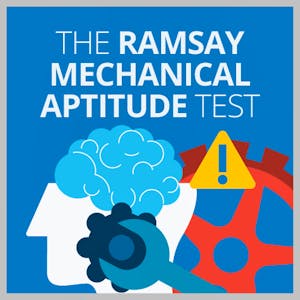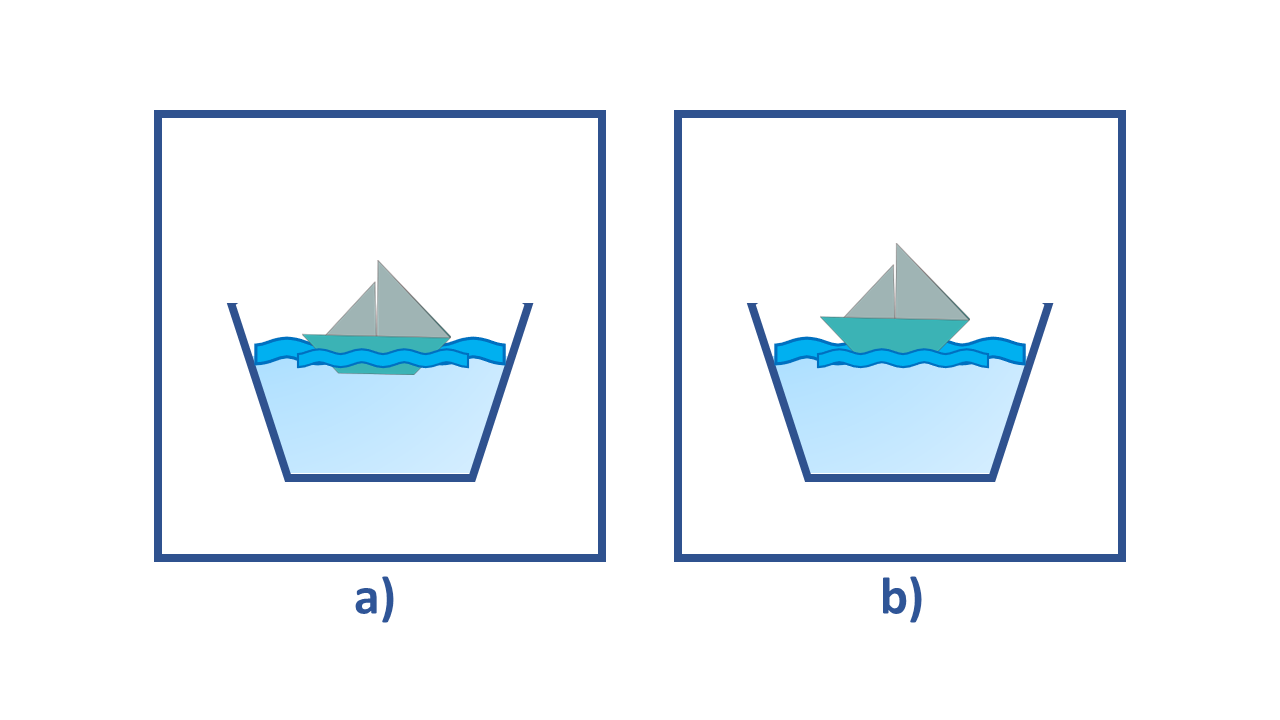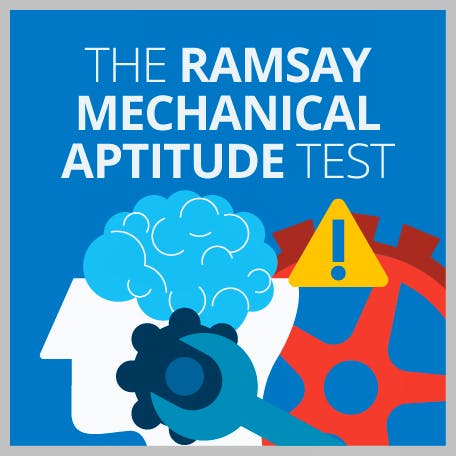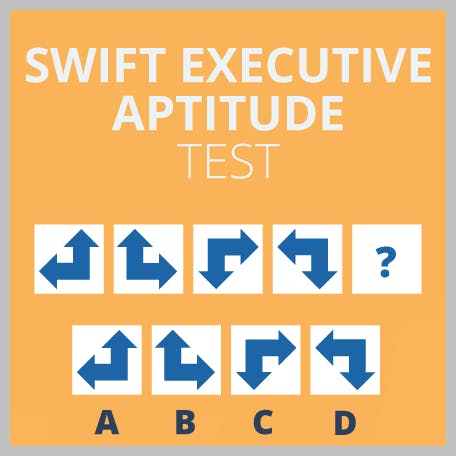A Guide to the Ramsay Mechanical Aptitude Test: Examples & Tips
Updated November 18, 2023

- What Is the Ramsay Mechanical Aptitude Test?
- Ramsay Mechanical Test Types
empty
empty
empty
empty
empty
- Format of Ramsay Mechanical Test
- Ramsay Test Practice Questions
- How Is the Ramsay Mechanical Test Scored?
- Tips for the Mechanical Aptitude Test and How to Prepare
- Frequently Asked Questions
- Final Thoughts

The Ramsay Mechanical Aptitude Test is used as part of the pre-employment screening process for a number of roles in different industries.
It is an excellent indicator of how well you can learn on the job, as well as your ability to use basic physics principles and mechanical knowledge to solve problems.
In this article, you will learn more about which job roles require completion of the Ramsay MAT as part of the application process, and what different types of tests are available.
The format of the assessment, as well as the number of questions and the time limit, will also be discussed. You’ll also learn how the Ramsay MAT is scored and what happens next.
There will be example questions that are similar to those you are likely to find on the assessment, as well as some top tips for success.
What Is the Ramsay Mechanical Aptitude Test?
The Ramsay Corporation was established back in 1973, and it is a well-regarded HR consultancy firm that specializes in helping companies find the right employees through an effective pre-employment selection process.
The Ramsay MAT was first established in 2004, and the current iteration of the assessment that is being used is the MAT-4.
Ramsay has also developed a specific version of the MAT for Amazon, which is widely used in the recruitment of tech employees. Other major employers such as Coca-Cola use the MAT as part of their application process.
Ramsay has become most well-known for developing aptitude tests for use in technical, maintenance or operational job roles across different industries. You might expect to take the MAT if you are applying to a role such as:
- Millwright
- Engineer
- Plumber
- Electrician
- Maintenance technician
- Tool setter
The main purpose of the Ramsay MAT-4 is to assess candidates on their ability to solve problems using mechanical reasoning and the application of their knowledge of physics principles.
This is a good indicator of ability in the mechanical field, but also of the candidate’s learning ability.
Ramsay Mechanical Test Types
Although much of the basic structure of the Ramsay mechanical tests are the same, there are some differences in the tests depending on the level of role that you have applied for.
Mechanical Aptitude Test (MAT)
This is aimed at apprentices and entry-level roles like mechanics. In the Ramsay aptitude test, you will be asked questions about basic mechanical principles to assess your aptitude. The Ramsay MAT test has 36 questions to be answered in 20 minutes.
This is the most common version of the assessment and the one that is discussed in detail throughout this article.
Maintenance/MultiCraft
The maintenance and MultiCraft version of the Ramsay test is aimed at journey-level staff, for roles in maintenance and repair, usually.
In the Ramsay MultiCraft test, you must demonstrate your mechanical and electrical knowledge by answering 60 questions in an hour.
In this Ramsay test for maintenance mechanics, there are fewer illustrations or images, and you need to be able to complete mechanical reasoning questions in written form, with fewer options for possible answers.
This is where doing paid for or free Ramsay MultiCraft practice tests and using Ramsay MultiCraft Test study guides will really come in handy. You can use your Ramsay maintenance test answers to assess which areas you need to focus your study on.
Amazon Maintenance Technician Test
The Amazon version of the Ramsay test is significantly longer than other tests in this range, lasting two hours and covering 75 questions.
The Amazon Ramsay test is split into:
- Level 1 (sometimes known as the Ramsay Maintenance Technician 1 test)
- Level 2 (also referred to as the Ramsay Maintenance Technician 2 test)
The assessment that you will take depends on the seniority of the role you have applied for.
ElecTest
Aimed at journey-level electricians or electrical maintenance applicants, this assessment is based on specific electrical knowledge and has 60 questions to be answered in an hour
Basic Skills
The Ramsay Basic Skills Test is an entry-level assessment that can be used to evaluate the mechanical knowledge of staff who might not be using these skills all the time but still need some working knowledge of physics principles and mechanical reasoning skills.
In this assessment, there are 52 questions, and it focuses more on things like inspections, process monitoring, and problem solving with some additional questions on arithmetic and reading.
Format of Ramsay Mechanical Test
The Ramsay Mechanical Aptitude Test is a timed assessment that you will take in your own time. It is usually used early in the application process, and you are sent a link to the assessment to complete it.
The test itself is relatively short, with 36 questions that must be answered in just 20 minutes.
Each question is based on an image, diagram or illustration, usually of a common household mechanical object or relating to some basic physics principle.
The questions are followed by multiple-choice answer options, and you must use your mechanical knowledge to choose the correct answer.
In the assessment, you can expect to find questions based on common household objects – including hand and power tools – and maintenance and production, as well as questions about science and physics.
You will be expected to have some knowledge about each of these subjects, but the assessment is looking more at your ability to apply this knowledge, rather than your depth of knowledge.
You should expect questions about:
- Force and movement
- Velocity
- Fluid mechanics
- Thermodynamics
- Electricity
Once you have completed the assessment, the recruitment team will receive a report containing all the information about your test, including whether you have reached the correct standard to pass.
The candidates who score highly enough will be taken forward to the next stage in the recruitment process, which is typically the interview stage.
Ramsay Test Practice Questions
1. Which of the following items will heat quicker in a microwave?
a) A bowl of soup
b) A beef burger
c) Both will heat at the same rate
2. Which type of valve is the best when you require precise, low flow?
a) Check
b) Gate
c) Needle
d) Both a) and b)
3. What can stop a compass from pointing North reliably?
a) Not close enough to the North Pole
b) A strong electromagnetic field nearby
c) Being in the southern hemisphere
4. Which of the following is not a form of energy?
a) Heat
b) Kinetic
c) Sound
d) Friction
5. According to the above image, which floating item is heaviest?

How Is the Ramsay Mechanical Test Scored?
The Ramsay MAT is scored according to the number of right answers you get in the assessment. Your score is presented as a pass or a fail.
The recruiter will receive a report on your score once you have completed the test.
In the report, the scores are given as an overall score, as well as sub-scores for the different sections.
The final report shows three different scores:
- Qualification Score – Pass/fail. This is based on your overall score.
- Local Score – The comparison of your score against other people who have applied for the same role as you.
- National Score – Your score compared to every test taker who has ever taken the Ramsay MAT-4.
While the pass mark needed to be taken further in the application process depends entirely on the needs of the role that you have applied for, in realistic terms you should be aiming for a score of at least 80%.
In most cases, recruiters will only take the top 20% of test takers further.
If you do not meet the required pass mark on the Ramsay MAT, your application will not continue, and you will not be invited to the next stage of the hiring process.
However, depending on the role and the rules of the company, you may be able to reapply for the job at a later date and retake the MAT.
Tips for the Mechanical Aptitude Test and How to Prepare
Step 1. Review Basic Principles
This is one of the most important things that you can do to improve your chances in the Ramsay MAT.
While you are not expected to have deep industry-level knowledge of mechanics, you will be expected to have a high-school knowledge of physics principles and be able to understand the way that basic household appliances and power tools work, for example.
You should revisit your knowledge on things like:
- Gravity
- Circuits, voltages and currents
- Acceleration
- Light, reflections and refraction
- Pressure
- Sound and acoustics
- Contraction and expansion
- Torque and levers
Step 2. Understand the Question Types
If you are taking the Ramsay MAT-4, you will be expecting to see questions that are based on an illustration or a schematic.
Be prepared to be able to read diagrams and understand what is being asked of you.
There is less than a minute available to answer each question, so be sure that you know what type of answer you are looking for by reading the question and studying the provided image.
Step 3. Take Mock Exams Online
Practice makes perfect, and online mock exams are a great way to improve your performance in the real assessment.
Take a mock exam based on the Ramsay MAT before you begin revising your knowledge so that you have a starting point and can find out where your weak spots or gaps in your knowledge are.
This will help you focus your studying on the parts that you find most challenging.
Taking regular paid for or free Ramsay practice tests will also help you to see how you are progressing in your revision – your score should keep increasing.
Step 4. Rely on Your Experience
If you already have mechanical knowledge, or a natural affinity for mechanics and physics, then rely on that throughout the assessment.
Your experience will be based on the same physics principles that are being used throughout the assessment, so don’t second-guess yourself.
Step 5. Read Questions Carefully
Some of the Ramsay test questions might be written in such a way to confuse you and get you thinking about the wrong problem, so by relying on your reading skills, you will feel confident enough to spot what the question is actually asking.
Those extra couple of seconds could make the difference between a correct answer and a mistake.
Step 6. Don’t Get Stuck if You Aren’t Sure
Even with all the revision time in the world, you might still get stuck on a harder question.
If this is the case, don’t spend hours on it – move on, and come back at the end if you have time. Wasting time on the tougher questions could mean missing some easy points.
Step 7. Answer All the Questions
The time limit for the Ramsay MAT is tight, with less than a minute for every question.
This means that getting through the assessment and answering all the Ramsay test questions can only come from being strict and not spending too long in the details – if you don’t know the answer, move on, because there is likely to be another question ahead that you do know the answer to.
Step 8. Give Yourself the Best Chance for Success
Preparation is key for any assessment, and with the Ramsay MAT you might not have a lot of time to prepare before the test has to be completed.
Leaving any revision to the last minute is not going to help you feel relaxed or focused and could risk you missing out on a good score.
Step 9. Fuel Yourself
One of the most important things that you can do is fuel your body and mind before the assessment.
Make sure that you get enough sleep the night before, eat a healthy, balanced meal and stay hydrated. Giving your brain what it needs will help ensure that it can perform well when you need it to.
The Ramsay Mechanical Aptitude Test (MAT) is a pre-employment screening assessment commonly used in the application process for roles where mechanical knowledge is needed.
The assessment is quite short and focuses on physics principles and the mechanics of everyday household items.
The Ramsay MAT is designed to be used to assess candidates at an entry level, including apprenticeships.
It is not necessarily difficult in terms of content, but there are 36 questions to be answered in just 20 minutes, so there is a lot of pressure that can make the test harder.
There are plenty of online resources to help you prepare for the Ramsay Mechanical Aptitude Test.
Some of the resources like this one give an overview of what to expect, while others like the resources on JobTestPrep actually provide practice tests, revision guides and other helpful information to ensure that you have all you need to pass.
The Ramsay Mechanical Aptitude Test assesses a candidate on their ability to solve problems using mechanical reasoning, and it also provides recruiters with information about how easy a candidate will find learning a new role.
Mechanical comprehension is essential for roles that are industrial in nature.
The Ramsay Mechanical Aptitude Test has a time limit of just 20 minutes, and in that time, you need to answer 36 questions.
If you do not achieve the required score in the Ramsay Mechanical Aptitude Test set by the company you have applied for, then your application will not proceed further.
You may retake the test if the business allows you to reapply for the same position at a later date.
There are many different roles that need mechanical understanding, and the Ramsay Mechanical Aptitude Test is used in the application process for many jobs, such as:
- Maintenance technicians
- Millwrights
- Engineers
- Mechanics
- Plumbers
- Electricians
- Machine operators
The score you will need to achieve on the Ramsay Mechanical Aptitude Test will depend entirely on the company you have applied for, and the level of the role in question.
In most cases, only the top performing 20% of the test-takers will be invited further into the recruitment process.
Any source of physics knowledge and principle would be a good place to start, but for specific knowledge relating to the Ramsay Mechanical Aptitude Test, you should consider resources such as WikiJob, this site and JobTestPrep.
The prep pack from JobTestPrep will give you all you need to achieve a higher score, from practice tests to revision material.
The Ramsay Mechanical Aptitude Test covers a number of basic physics principles and mechanical knowledge.
Some of the topics that are covered include:
- Electricity �– circuits, current, voltage
- Light – reflection and refraction
- Sound – energy and acoustics
- Force
- Acceleration
- Gravity
- Condensation and evaporation
- Newton’s Laws
- Ohm’s Law
- Pressure
- Hydraulics
The Ramsay Mechanical Aptitude Test is usually used early in the recruitment process for engineering or other hands-on roles as a pre-employment screening test.
After you have completed the test, the recruitment team will receive your score and decide if you have achieved the desired level to be taken further in the process.
If you are successful, the next step is usually an interview. If you are unsuccessful, then your application will not be taken any further.
You can find more sample questions, as well as a whole host of useful information including complete practice tests, revision materials and handy hints to help you pass the Ramsay Mechanical Aptitude Test, on JobTestPrep.
Final Thoughts
The Ramsay Mechanical Aptitude Test is a useful assessment for recruiters who are looking for the right candidates to hire for roles that require mechanical reasoning aptitude.
It is a quick and relatively simple assessment that can be taken early in the recruitment process and used to gather data about applicants related to their suitability for the advertised role.
For the candidate, it is a simple and quick assessment that can be taken at home, and it requires no specialist job-related knowledge (just some high-school-level understanding of physics principles).













